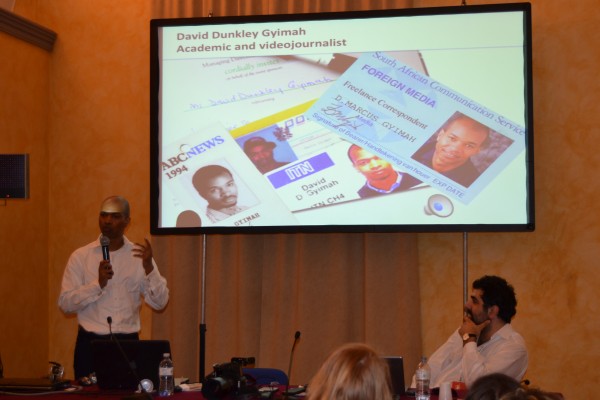Just like art, videojournalism has undergone many changes in the last few years. Movements in both visual spheres are more similar than one might imagine. Dadid Dunkley Gyimah of the University of Westminster, and Marwan Maalouf, co-founder of Menapolis, spoke to this during their presentation “New narratives in videojournalism,” which took place during the 2014 edition of Perugia’s International Journalism Festival.
For the last six years David Dunkley Gyimah has been studying a topic considered rather controversial by many of his collegues. And, while preparing to finally publish his research in a week, he shared several key notes from his PhD with the public.
Giving a brief history excursus, the speaker insisted that the common way the news is presented nowadays will be altered in the near future. In fact, it’s a process that has already begun. Operating with the original definition of the word ‘cinema’ given back in the days by the most famed Russian film theoretic Dziga Vertov, David Dunkley Gyimah stated that traditional news packages will become a synthesis between standard reporting and cinema. The modern audience prefers cinematic experiences, and news outlets should take this fact into consideration.
Content viewers and practitioners tend to make sense of image and sound in a very specific manner: Television is in the inner circle, followed by documentary, cinema, and art as the outward circle. Today, documentary films that have a more cinematic look already exist, and David Dunkley Gyimah shared as an example a film that he shot with Marwan Maalouf in Syria.
However, news packages that occupy the spot between television and documentary are just starting to emerge. The presenter conducted several experiments in order to understand what kind of impact both types of news packages have on the audience. He asked his master’s students at the University of Westminster to give their opinions on the same video feature which was edited during the post-production in two completely different ways. The first feature was edited according to the traditional packaging rules: voice-over, interview, voice-over, interview. The second one had a ‘documentary’ vibe, and as the audience at the panel noted, felt more ‘personal’.
The first video edit was decribed by the students in the following way: ‘[It] is like news because it has a voiceover, interviews and background music; it is presented in a third person view’. The second one was said to be ‘like cinema with the individuals speaking out their own feelings and throughts all throughout the video clip; it is presented in a first person view’.
The attendees at the panel agreed, pointing out that perhaps the documentary-styled news package was more appealing because it gave the sense of a more significant time commitment, which in reality was not the case. The perfect example of a television station that is currently working in such manner is Vice. Interestingly enough, a lot of the techniques Vice is using today were established back in 1994 when Channel One (UK) was founded. That channel didn’t exist for long, but the majority of their materials embodied the tendency that David Dunkley Gyimah spoke about.
Using several criteria such as ‘rule of third vs central framing’, ‘mobile doc handheld vs steadicam’, ‘shot reverse shot vs noddy’, length of the film and terms of ref (eg. GVs), David Dunkley Gyimah singled out several characteristics which are inhered by the video content occupying the ‘television-documentary’ position.
First of all, news packages like these are edited directly during filming. The video journalist is supposed to see the so-called patterns. Unlike regular television correspondents whose goal is just to tell the story, the cinematic news journalist is supposed to see the occuring situation in a very photographic way, in other words, ‘to see the patterns’. As the presenter explained, it is the ability to edit directly based on reactions of different event participants. The journalist has to see a film scene and analyze it on the spot. ‘Pattern detecting is part of what cinema is actually trying to do in real life’, said David Dunkley Gyimah.
Secondly, all the shots within the ‘new’ news reports have to contain meaning. For example, in the traditional package cut aways are used to disguise the editing and mistakes; in the documentary styled packages each cut away has a contextual sense to it.
But the altered videojournalism is not just about the way it’s filmed or edited. ‘Cinema is about detecting (explicit and implicit) on the ground and making decisions, particularly as videojournalism bridging images and words’, said the senior lecturer of the University of Westminster. He added that personalisation is a major key in the success of this emerging trend and also predicted the possibility that video essays will become more popular.
In short, David Dunkley Gyimah re-examined videojournalism and re-imagined it as a brand new storytelling form which merges several media disciplines, including cinema. Therefore, the above mentioned forms do not exclude, but compliment each other and co-exist.
The question that arises is ‘how to teach television journalism now?’ The line between cinema-fact and cinema-fiction becomes very thin, and the audience cannot always tell the difference. That creates an opportunity for propaganda, which in the wrong hands can lead to devastating results. Yet what is often considered propaganda can just be journalism in the specific area. David Dunkley Gyimah defines ‘journalism as a cultural form shaped by literary conventions and social practices’, which is rather true.
The fact is today there’s no news as it was in the 1960’s. The panelist was confident that the future of videojournalism lies in the merging of television, documentary and cinema. Just as the impressionists changed the world of art, the journalists who are willing to try new collisions will create stories and video content so rich and powerful that the media landscape will be altered forever. It might not happen tomorrow, but there’s evidence that it will happen eventually.
Lillie Mazitova
